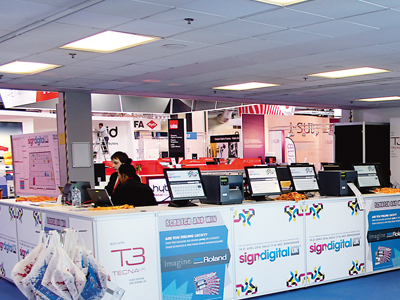While there was plenty to see at this year’s show, some of the most interesting things were the systems used to construct the stands themselves.
Coming between Fespa and drupa Sign & Digital UK this year was, while a good chance to see the launches from Fespa if you could not make it yourself, not a bumper years for many other launches as vendors chose to save a little showmanship for Dusseldorf.
It was worth the trip though for more than just the above-mentioned reason of seeing the Fespa launches on UK soil. One of the biggest things at the show was to a very large part behind the scenes – and you might have missed it if you weren’t looking for it. That was the increasing adoption of graphic support and stand build systems. Leading the way was Tecna UK, the UK agent for the Tecna T3 system. At least 10 of the stands at the show, along with the frontlit and backlit displays lining the show entrances and the reception desks were built using the system. With the diversity of graphics, styles and sizes exhibited those stands looked like they were custom built. That diversity of appearance, but all based on the same simple system highlights the potential for printers to extend their services by adopting such a system, which is easy to design for and configure.
Stands that deliver
‘It’s Meccano for adults,’ said Tecna UK managing director Simeon xxx. ‘Printers know the graphic sides of the display business but struggle to know what to put their print onto. This system is the answer, and by being able to supply a complete display system they can sell more graphics.’
The firm believes that its system offer an opportunity for printers looking to provide customers with a more complete offering without the need to acquire too many new skills or equipment. That could include hiring out the systems for one-off events, selling systems along with graphics or providing a complete managed service. To make that simpler it offers a white label website and other marketing tools to help selection and configuration.
Tecna UK estimates that the investment in a basic set of components that could be used to offer a rentable system to be £5,000.
While Tecna UK sells the T3 system in the UK, the developer of that system Tecna Design is a separate, and UK-based business. It used the show for the European launch of a new display system called T3 Affinity, which it developed in collaboration with Chinese manufacturer Lintel, which is part of the Ling Tong Group. It claims that the partnership combines the best of UK design with the strength of Chinese manufacturing and development, at a cost effective price.
Tecna Design managing director Jonathan Evitt, who designed both systems, is an exhibitions industry veteran. He developed the original system a dozen years ago when he saw that due to the capabilities unleashed by wide format printing the future of exhibition and display stands would become far more dependent on the graphic imagery used. So he developed a flexible and affordable system for building displays that maximised the graphic component and made it easy to change the messaging.
Cutting a dash
UK cutting specialist Blackman & White won’t be going to drupa, and so chose the home show to display its latest developments.
It launched a new software interface, developed in conjunction with its US distribution partner MCT. The self-developed package replaces and off-the-shelf system, and was based on the need to have something that the firm could customise to meet user requests.
‘Our customers were always asking for special features, which we couldn’t accommodate with an off-the-shelf package, so the only option was to write our own,’ said B&W managing director Alex White.
The new software also offers a new approach to registration when combined with a new digital camera vision system.
‘Now we can use a unique registration mark for each element, so the operator doesn’t have to match the job on the machine to the right cutting file,’ said Mr White. He added that it also enables the operator to adjust the cutting registration to the graphic, which he said was a critical feature for the increasing amount of textile work as it allows compensation for the distortion of the image caused during washing or transfer.
Mr White claimed it was the first cutting software for the graphics market developed to consider the needs of textile production.
Blackman & White’ Versatech cutter, which was on display at the show is unique in being designed to offer cutting using lasers and more conventional knives and routers on a single machine. It achieves that using a special quick changeover metallised belt that is required for use with the laser. Machines can either go out configured with both cutting technologies, or the laser can be added later in the field.
At the other end of the scale is Italian materials processing giant Biesse, which has recently started targeting the sign & display market with a range of its products. The firm’s heritage is in woodworking and other materials processing sectors, which means it can offer a broad base of experience, high levels of support with extensive engineer coverage and due to economies of scale in its manufacturing very competitive pricing for its machines, which are targeted for the more specialist routing and milling applications rather than cutting paper and board.





